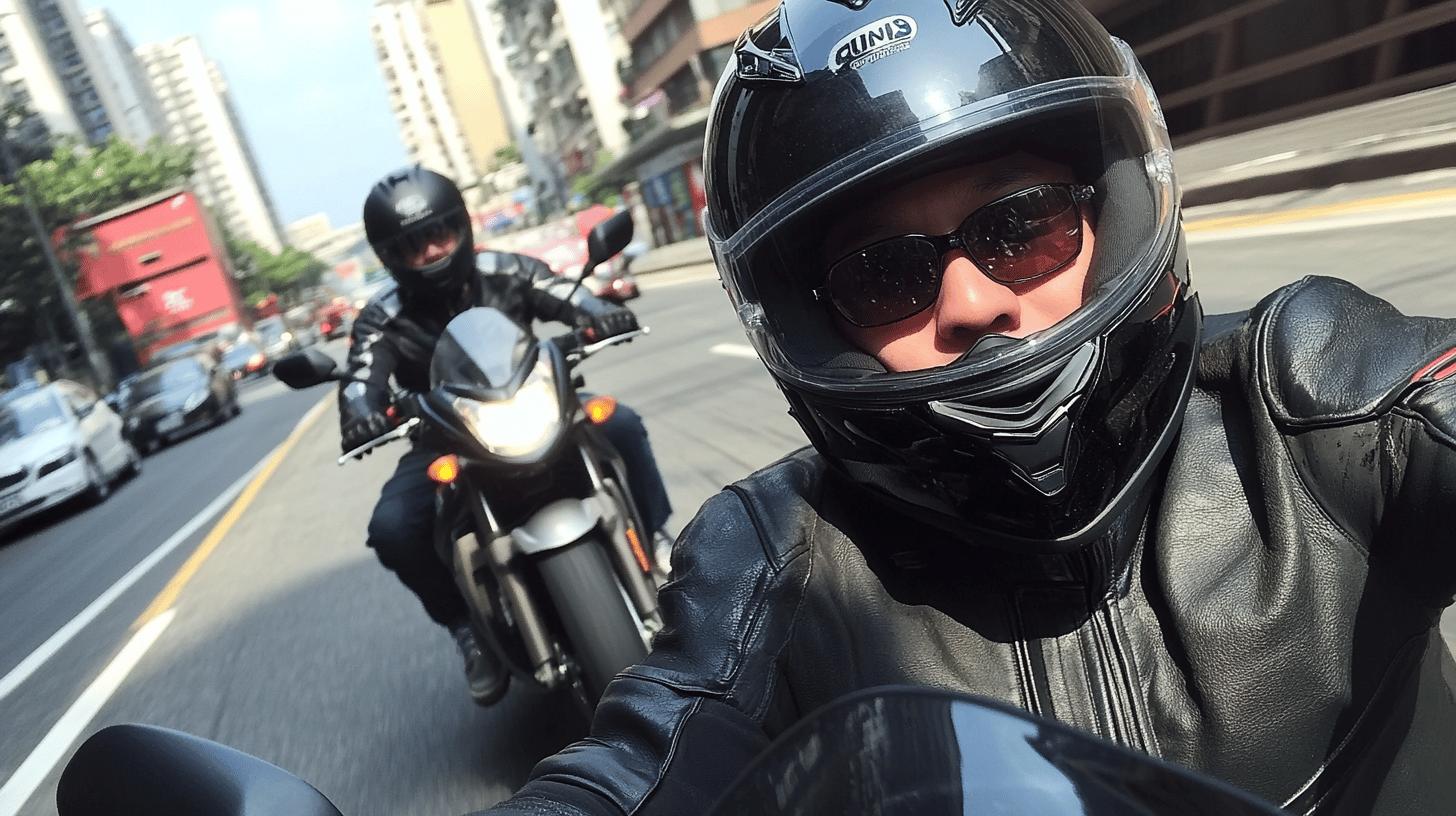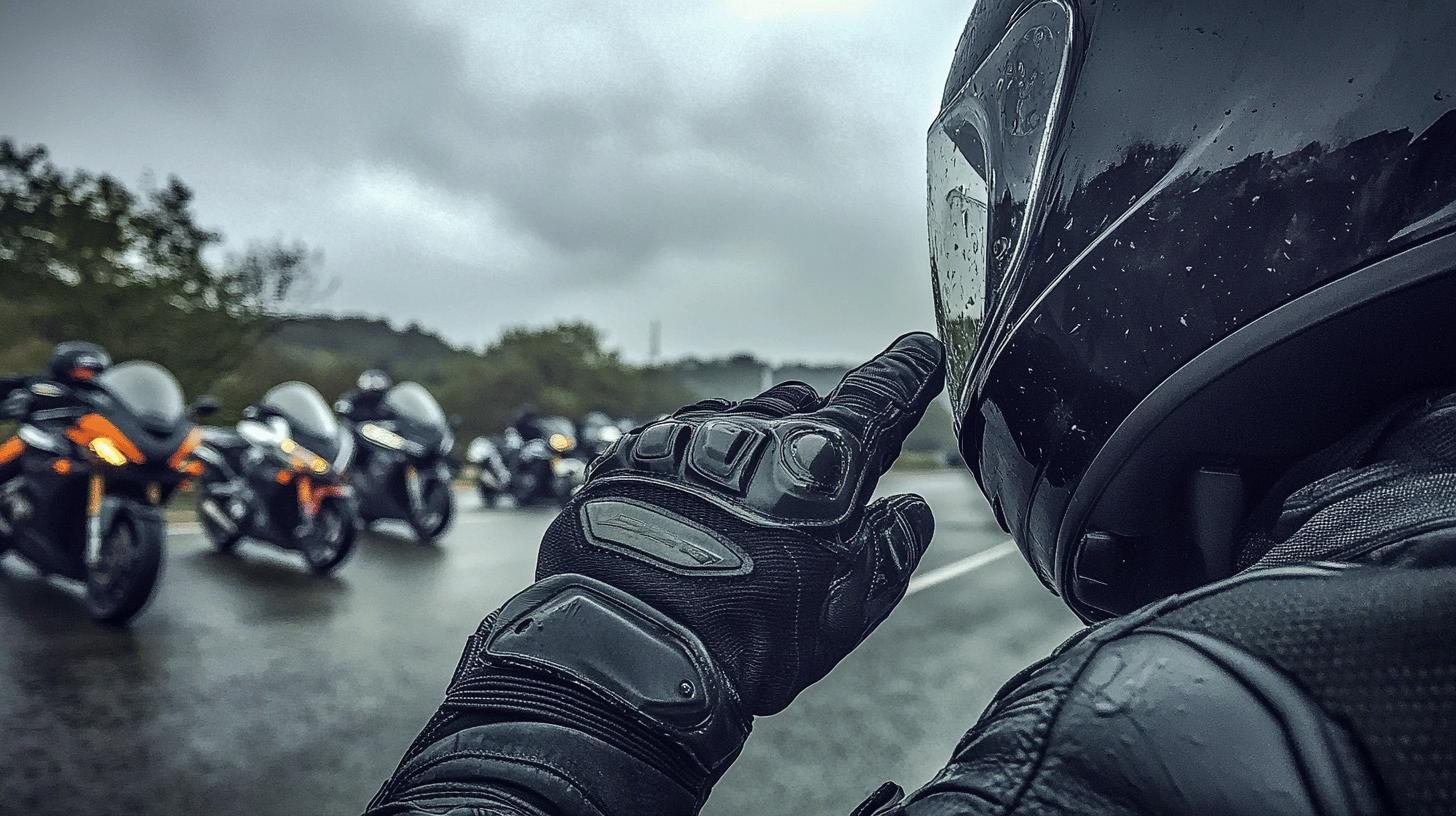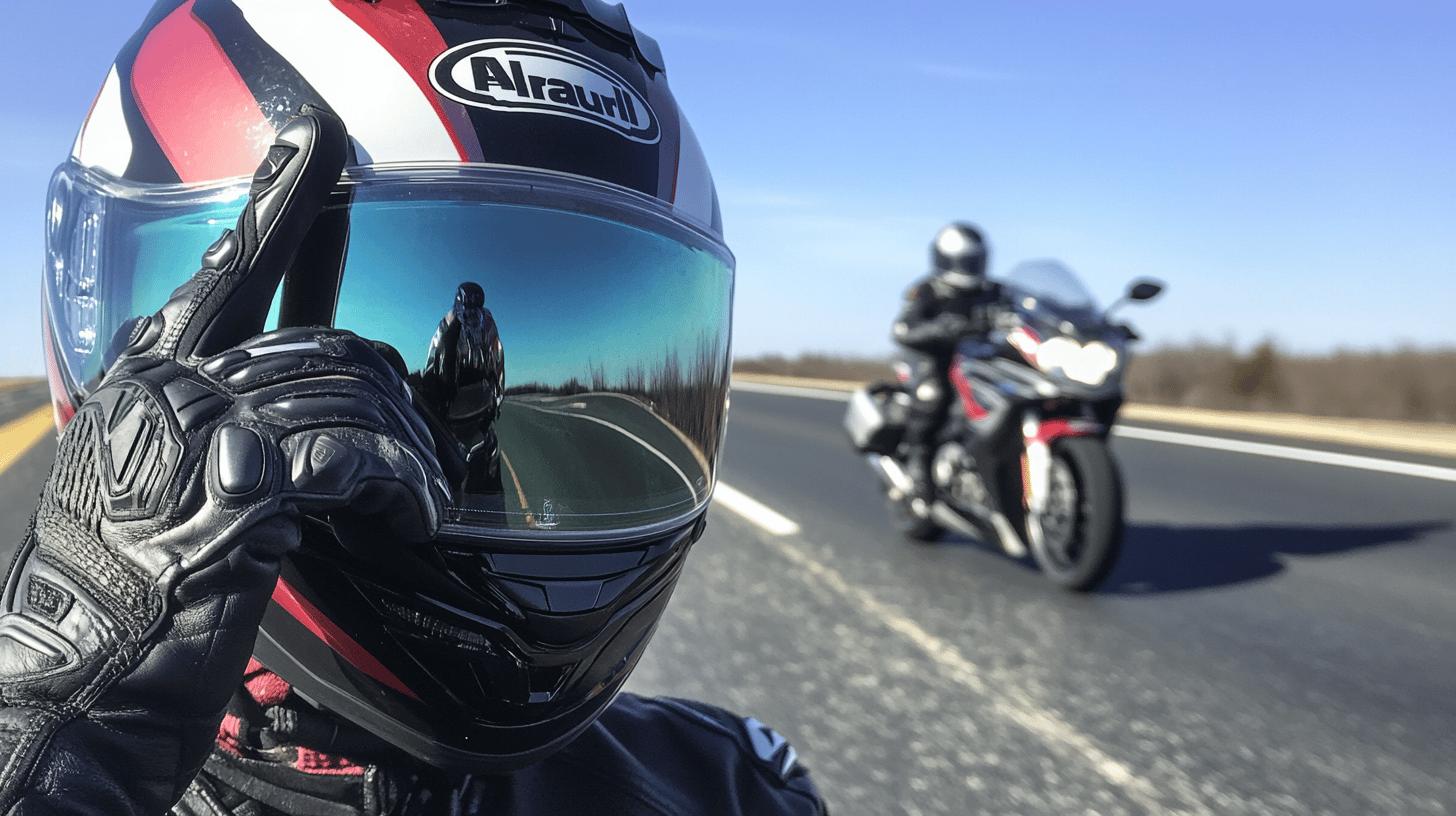Ever encountered a motorcyclist tapping their helmet and wondered what it signified? This small gesture packs a powerful warning in the biking world. Among riders, tapping the top of the helmet serves as a crucial signal to indicate the presence of law enforcement ahead.
It's more than just a casual nod; it's an essential component of rider communication that enhances safety and fosters community. By understanding this signal, amateur motorcyclists can foster greater safety and trust on the road.
Explore why this gesture is a staple of riding and its significance in motorcycling culture.
Understanding the Helmet Tap Gesture

When a motorcyclist taps their helmet, what does it mean? In the context of motorcycling, this gesture is widely recognized among riders as a non-verbal cue indicating the presence of law enforcement ahead.
This silent signal serves as a warning for fellow bikers to exercise caution and reduce speed. It is a crucial component of riding culture that underscores the importance of communication and safety on the road. Helmet tapping is a universal gesture among motorcyclists, fostering a sense of camaraderie and mutual assistance.
Common scenarios or reasons for using the helmet tap include:
-
Alerting riders to the presence of law enforcement.
-
Signaling a need to reduce speed and exercise caution.
-
Indicating potential hazards or obstructions on the road.
-
Encouraging riders to regroup or maintain formation in a group ride.
-
Enhancing overall group communication and cohesion.
The significance of helmet tapping in rider communication cannot be overstated. As a non-verbal cue, it bridges the gap when verbal communication is impossible due to noise or distance. This gesture enhances collective awareness and promotes safer riding practices by providing timely alerts about potential dangers.
In addition to improving individual safety, helmet tapping contributes to a safer riding environment for all, reflecting the shared responsibility and support within the motorcycling community.
The Role of Helmet Tapping in Motorcycle Communication

Helmet tapping is a fundamental aspect of motorcyclist communication, serving as a non-verbal biker cue to convey critical safety warnings. When a rider taps their helmet, it signals to others the presence of law enforcement or potential hazards ahead.
This gesture is especially vital in traffic, where verbal communication is impractical due to the noise and distance between riders. By using these silent cues, motorcyclists can alert each other quickly and effectively, ensuring that all members of a riding group are aware of their surroundings and can adjust their behavior to maintain safety.
In the broader context of motorcycle communication, helmet tapping exemplifies how non-verbal signals are used to enhance rider awareness and safety. These cues are embedded in the culture of motorcycling, emphasizing the importance of looking out for fellow riders and maintaining a shared sense of vigilance on the road.
By tapping the helmet, riders not only communicate immediate road conditions but also foster a collective consciousness that enhances overall riding safety. This method of communication underscores the significance of mutual support among bikers, reinforcing the idea that the safety of one is linked to the safety of all.
Helmet Tapping: Origins and Cultural Significance

Where did the gesture of helmet tapping come from? This practice has its historical roots deeply embedded in the motorcycle riding culture. Initially, it emerged as an informal communication method among riders who needed to convey messages without spoken words.
Over time, helmet tapping became a standardized signal, widely recognized within the biking community for its efficiency in conveying important alerts, particularly about law enforcement presence.
The evolution of helmet tapping reflects the broader development of non-verbal cues in motorcycle culture. As motorcycles became more popular, the need for clear, silent communication grew. Riders adapted and refined gestures like helmet tapping to enhance safety and mutual understanding.
This evolution also underscores the adaptive nature of motorcyclists who often ride in noisy environments where verbal communication isn't feasible. The helmet tap has thus become an integral part of the non-verbal communication toolkit for bikers.
Culturally, helmet tapping signifies more than just a warning. It embodies the solidarity and mutual assistance that are core values in the motorcycling community.
By tapping their helmets, riders express a sense of responsibility for the safety of others on the road, reinforcing a shared bond among bikers. This gesture is a reminder of the camaraderie that defines motorcycle culture, where each rider looks out for their fellow travelers.
Understanding these cultural norms provides insight into the sense of community within the biking world. Helmet tapping is not merely a practical gesture; it's a symbol of the supportive network that exists among motorcyclists.
By embracing such practices, riders contribute to a cohesive community that values safety, communication, and mutual respect. This cultural significance highlights the importance of maintaining these traditions to preserve the unique spirit of motorcycling camaraderie.
Helmet Tapping as a Safety Measure

What does it mean when a motorcycle taps his helmet? The immediate answer is that it serves as a critical safety signal among riders. This gesture alerts fellow motorcyclists to slow down or be cautious due to the presence of law enforcement or other potential hazards. In the context of riding, it functions as a non-verbal communication tool that enhances safety by providing timely warnings on busy roads.
Specific safety situations where helmet tapping is beneficial include:
-
Notifying about the presence of law enforcement officers.
-
Indicating roadblocks or traffic congestion ahead.
-
Signaling the need to reduce speed in high-risk areas.
-
Warning of unexpected road conditions like debris or potholes.
-
Advising to regroup or maintain formation during group rides.
-
Enhancing visibility and awareness in low-light conditions.
Utilizing helmet tapping as a signal in motorcycling can significantly contribute to road safety. By adopting such non-verbal cues, riders can prevent potential accidents, maintain awareness, and react promptly to changing road conditions.
This practice not only helps individual riders but also fosters a safer riding environment for all, highlighting the shared responsibility of motorcyclists to look out for one another. The consistency of this gesture within the community reinforces its effectiveness, ensuring that signals are understood universally among those on the road.
Helmet Tapping in Group Riding Dynamics

In group riding, communication is paramount to ensure the safety and cohesion of the formation. Riders rely on a series of non-verbal signals to convey important information quickly and clearly, given the challenges posed by noise and distance.
Helmet tapping is a critical component of these group riding signals. It allows riders to alert the group to situations such as law enforcement presence or road hazards without breaking formation or creating confusion. This gesture helps maintain a synchronized flow, which is essential when riding in close proximity.
Within the dynamic of a riding group, helmet tapping serves as an integral signal that complements other cues used to manage and guide the formation. When a group leader or any rider taps their helmet, it sends an immediate message to everyone in the group to be vigilant or adjust their speed.
This action is particularly useful in maintaining the integrity of the group, as it ensures that all members are aware of external conditions that may require a collective response. Helmet tapping, therefore, is not just about individual safety, but about preserving the unity and coordination of the entire group.
| Signal | Meaning |
|---|---|
| Helmet Tap | Law enforcement or caution ahead |
| Point to Sky | Single file formation |
| Point Down with Foot | Hazard on the road |
| Patting Head | Need to regroup or stop |
| Raise Fist | Prepare to stop |
The benefits of using helmet taps and other signals during group rides are manifold. They enable riders to communicate crucial information swiftly, reducing the likelihood of accidents caused by miscommunication. By relying on a standardized set of signals, groups can navigate traffic more effectively and respond to changing conditions as a unit.
This method of communication fosters a sense of trust and cooperation among riders, reinforcing the idea that safety is a shared responsibility. Through helmet tapping, motorcyclists can maintain group cohesion, ensuring that each ride is not only enjoyable but also secure.
Final Words
Diving into the world of helmet tapping reveals its pivotal role in motorcyclist communication. This gesture acts as a vital signal for alerting fellow riders of law enforcement presence, enhancing road safety, and fostering community ties.
Understanding what does it mean when a motorcycle taps his helmet connects riders to a rich tradition of shared awareness. Embracing these practices enriches the riding experience, ensuring both safety and camaraderie for all on the road.
FAQ
What does tapping your helmet mean when riding a motorcycle?
Tapping a motorcycle helmet signals other riders of law enforcement presence ahead, advising them to reduce speed and exercise caution.
Is tapping your helmet illegal for motorcyclists?
Tapping your helmet is not illegal for motorcyclists. It is a common non-verbal communication tool used to improve safety on the road.
What does it mean when a motorcyclist points to the ground?
When a motorcyclist points to the ground, it usually signifies a hazard, such as debris or potholes, alerting fellow riders to navigate safely.
What does it mean when a biker points two fingers down?
A biker pointing two fingers downward indicates solidarity and respect among riders, commonly interpreted as a "stay safe" gesture.
What significance does helmet tapping have in motorcycle riding culture?
In motorcycle culture, helmet tapping is significant as a symbol of community and mutual assistance, reinforcing solidarity among riders.
How does helmet tapping fit into broader motorcycle communication?
Helmet tapping is an integral part of non-verbal biker cues, playing a crucial role in increasing safety and awareness by alerting potential dangers.
What are some common motorcycle hand signals?
Common motorcycle hand signals include turning left or right, slowing down, stopping, and other gestures that communicate intentions within a riding group.

Mark Anderson is a trusted expert with over 25 years of riding experience. At 56, his deep knowledge of long-distance touring and participation in major motorcycle rallies makes him a reliable source for gear recommendations on ProtectiveGearz. Mark’s decades of firsthand experience ensure his advice is authoritative and valuable to riders seeking expert guidance.



